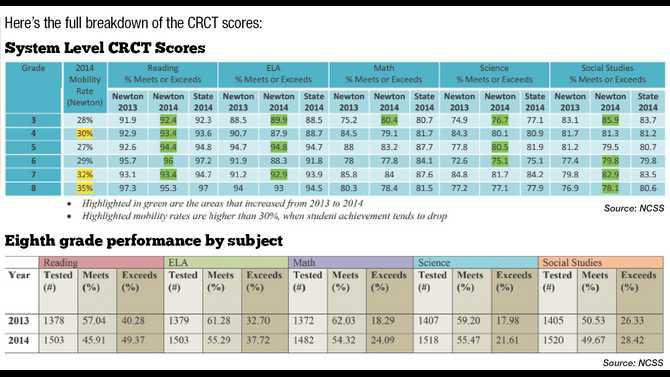Amid announcements of and preparations for a new testing system for public schools throughout the state, signs of both growth and decline were represented in the final year of Criterion Referenced Competency Tests (CRCT) in Newton County schools.
The Georgia Department of Education (GADOE) released the 2014 CRCT scores June 25, showing the Newton County School System (NCSS) matched or surpassed the state average in seven of 30 performance areas and having improved in 16 areas from 2013.
Scores were calculated as a percentage of students in each of grades three through eight who met or exceeded the state’s expectations for the standardized test in the academic areas of reading, English language arts, math, science and social studies. CRCTs are aligned with the Common Core Georgia Performance Standards (CCGPS) as required by state law and are scaled to represent three levels of passing or failing.
CRCT assessments are generally structured to range from 650-900, with a score below 800 indicating a “level of performance that does not meet the standard,” according to the 2013 CRCT Score Implementation Guide provided by the GADOE. Scores from 800-849 indicates the student “meets the standard,” and an 850 or above indicates the student “exceeds the standard.”
Current data do not reflect retest scores, which should be released late this month, according to an NCSS press release.
“I greatly appreciate the focused work and dedication of our NCSS team,” said NCSS Superintendent Samantha Fuhrey. “Our teachers have been working diligently to implement the (CCGPS) in reading, English language arts and math while maintaining a laser-like focus on the Georgia Performance Standards in science and social studies. A testament to their efforts is the significant increases noted in the percentage of students who have exceeded the standard on CRCT. We are better preparing students not only for the rigor associated with the new assessments but also for life beyond high school.”
Positive points
Overall, NCSS schools marked a 53 percent rate of improvement on this year’s CRCT tests. All grades except eighth showed increased pass rates on the reading assessment. Third-graders increased pass rates in all five assessments.
Grades three, five and seven had more students pass the English language arts CRCT than in 2013. Grades three, five and six passed a larger percentage of students on the science assessment, and grades three, six, seven and eight showed increases in passing students on the social studies CRCT.
Third-graders also outpaced the stage average in reading, English language arts and social studies. Fourth-graders did so in social studies as well as fifth-graders in English language arts.
Sixth-graders matched the state pass rate on the science and social studies assessments.
Other factors
NCSS Director of Testing, Research and Evaluation Allison Jordan looked into possible explanations for why certain grades score high or low in certain subjects.
She said when comparing eighth grade CRCT results from 2013 and 2014, she found that each subject had 100-200 more students taking the tests. This supports mobility rate research, which explores what happens when students switch schools often, whether intra- or inter-county.
Once the mobility rate reaches 30 percent, student achievement tends to decrease, Jordan said. High rates affect both the student who cannot acclimate to a stable educational environment and the student who does not move but has new peers coming and going from the classroom throughout the year.
Jordan said this may be a possible explanation for the decline in scores for eighth-graders – in every subject except social studies – from 2013-2014, whose mobility rate in 2014 was 35 percent.
“When analyzing our data for performance by category, we also noticed increased movement from the ‘meets’ to ‘exceeds’ categories in all subject areas for eighth and seventh grade,” Jordan said. “The number of students tested increased, which supports this high mobility rate for 2014. However, regardless of the challenges facing this transient student population, teachers increased rigor and more students reached the ‘exceeds’ level.
“That movement indicates curriculum is being taught as it should be.”
Needs improvement
While every grade saw more students reach passing scores in at least one category, only grade three posted gains in the math assessment from 2013-2014.
Twenty-three of the 30 performance areas – split between six grade levels and five CRCT tests – fell below the state average. The biggest gap was in sixth-grade math, which scored 6.3 percent below the state average.
The rigor of the math subjects taught and the tests administered to students this past year reflect an appropriate example of the new tests students will take next year. As the EOCT tests for high-schoolers are also being thrown out moving forward, all students in grades three through 12 will participate in the Georgia Milestones Assessment System (GMAS).
End of Grade (EOG) assessments for students in grade three through eight and End of Course (EOC) assessments for high-schoolers will be consistent across all grades instead of a series of individual tests and will include open-ended questions to better gauge students’ content mastery, according to the NCSS.
Test questions will force students away from a simpler “plug-and-chug” Scantron where guessing may produce a correct answer by requiring written explanations and citations from the problem to prove why an answer was chosen.
“These increased expectations for learning may mean initially lower scores than previous years’ CRCT and EOCT scores, but that is to be expected and should bring Georgia’s tests in line with other indicators of how students are performing,” said an NCSS press release.
“We are not satisfied with our results,” Superintendent Fuhrey said. “With continued focus on our non-negotiable goals of more effective teaching and increasing students’ performance, we expect to see continuous improvement overall.
“We appreciate our parent and community partnerships and cannot emphasize enough the importance of the role both play in regards to students’ achievement. High expectations of our students coupled with appropriate educational and community support will enable our students to be college and/or career ready.”





